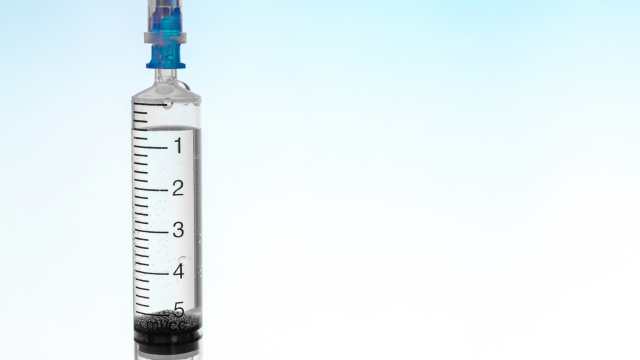
Have you considered what the ‘perfect’ level of shaking is for a pre-filled syringe? Or whether you should insert an intramuscular needle bevel up or down? Do you ever wonder just how far you should go with expelling air? Do you really like to get down to the details of the medicines you administer? Well, read on to enter the world of really picky debates around correct intramuscular injection technique.

Some vaccines come as pre-filled syringes as you well know. As they will have been sitting motionless for some time before you give them this may have led the contents to settle. Therefore, it would seem reasonable that a little mix won’t do any harm, and most manufacturers DO suggest a mix of some sort, and hence leave a small air bubble in the syringe to aid with the mixing process (more on air bubbles later). However, we must be careful to not damage the product so you don’t want to treat it like a set of maracas. This process, therefore, requires balance.
If you want a basic answer on the ‘to shake or not shake’ question the ultimate answer is always in the Summary of Product Characteristics (SPC) of that particular medicine*. However, if you’re picky, you might wonder what exactly a proper ‘shake’ entails. Some product SPC’s are slightly more detailed than others about the level of ‘shake’ you want to achieve.
Sanofi’s Split Virion Quadrivalent Influenza Vaccine SPC simply states: “Shake before use” (section 6.6).
Sequirus’s Fluad vaccine SPC says similar, but advises a ‘gentle’ shake (rather than a ‘standard’ shake??): “Gently shake before use” (section 6.6)
The Prevenar 13 SPC implies that shaking WELL helps with mixing and should be done first before preparing the syringe: “The vaccine should be shaken well to obtain a homogeneous white suspension prior to expelling air from the syringe” (section 6.6). Is this a ‘better’ shake than a Fluad-style shake?
Valneva also advise a well-shaken syringe for Ixiaro; “Before administration, shake the syringe well to obtain a white, opaque, homogeneous suspension” (section 6.6)
Pfizer, again, suggests a good old shake with Ticovac (again, as opposed to Fluad’s more gentle methodology?): “Shake well prior to administration to thoroughly mix the vaccine suspension”
Avaxim is made by the same manufacturer as the first influenza vaccine above and again Sanofi are brief with their advice, not specifying the level of vigorousness needed. They simply say “Shake before injection to obtain a homogeneous suspension”.
What do we do with this information to ensure we are performing correct intramuscular injection techniques? What IS a standard level of pre-shaking? I don’t really know – let me know if you do!
Well, this is also one that, again, we must refer to the SPC for*. Some vaccines come as a lypholised powder that needs to be mixed with a diluent in order to be administered. The lyphilasation process helps the vaccine to remain stable until ready to be used so that the expiry dates can be maximised. This is often the case with live vaccines (which are generally more unstable) but also applies to some inactivated ones too. Here are some examples of SPC advice on intervals for some common vaccines:

The MMR priorix SPC says; “The vaccine should be injected promptly after reconstitution. If this is not possible, it must be stored at 2°C-8°C and used within 8 hours of reconstitution.” (section 6.3). It seems that ‘promptly’ can also be as good as 8 hours later. PHEW!
The MMR Vax Pro SPC states similar; 8 hours after reconstitution is a reasonable timeframe if a vaccine can’t be administered promptly. So ‘promptly’ and ‘immediately’ can both be extended to 8 hours (as-long-as-it’s-in-the-fridge).
For correct technique, the Menveo SPC also suggests ‘immediately’ is somewhere prior to 8 hours elapsing: “After reconstitution, the medicinal product should be used immediately. However, chemical and physical stability after reconstitution was demonstrated for 8 hours below 25°C.”
The Varivax SPC states that ‘immediately’ is definitely less than 30 minutes. “After reconstitution, the vaccine should be used immediately. However, the in-use stability has been demonstrated for 30 minutes between +20oC and +25oC.” (section 6.3) AND this one can be out of the fridge too that whole time. Zostavax concurs “After reconstitution, the vaccine should be used immediately. However, in-use stability has been demonstrated for 30 minutes when stored at 20 °C – 25 °C.” (section 6.3)
Varilrix introduce a different phrase for promptly or immediately. They define it as ‘soon as possible’. So, what is the time period for ‘soon as possible’? The SPC states “After reconstitution, it is recommended that the vaccine be injected as soon as possible. However, it has been demonstrated that the reconstituted vaccine may be kept for up to 90 minutes at room temperature (25°C) and up to 8 hours in the refrigerator (2°C to 8°C).” (section 6.3).
The Shingrix SPC states; “After reconstitution: Chemical and physical in-use stability has been demonstrated for 24 hours at 30°C.” Wow, this is reassuring. However, like the others, they do have a preference for administering sooner than that, and certainly not normally be longer than 6 hours at 2°C to 8°C.” (section 6.3)
None of this tells us what exactly what ‘immediately’, ‘promptly’ or ‘soon as possible’ means if we want to be absolutely perfect at our jobs!! Combined with the notion that the cold chain is about storage and not administration (which implies room temperature administration is the ideal, so there has to be some kind of short wait) exactly how long should we hesitate before it becomes less than ideal?? Answers on a postcard please!

This is not a particularly well-researched area, but N. Kluger took a stab at it (excuse the pun) in December 2021. He concluded that ideally, we should avoid injecting into pigmented areas and we should follow this thought process:
And he suggests that NO vaccines are to be given into a fresh tattoo (less than 30 days old) which is essentially an open wound. And he also suggests that vaccinees should be advised not to have any tattoos in that area for 30-60 days. But there is still more work to be done in this area to confirm these suggestions.

Another SPC question*. However, let’s explore the principles of this. When giving an intramuscular injection, a small air bolus is not likely to cause any harm. In fact, it can help by forming a bit of an airlock to avoid escaping product (plus preventing local reactions). It also ensures every last bit of product has been administered and not left in the needle, hence avoiding wastage and under-dosing.
When you are using a pre-filled syringe the air bubble is inserted during the manufacturing process (this enables the vaccine to be shaken ‘well’, ‘gently’, or ‘vigorously’ to mix) and it is likely to be very small.
Some manufacturers leave it to clinical judgement about whether it should stay or go before entering the patient and don’t comment either way on the correct technique.
For example, the Ticovac SPC says; “After removing the syringe cap, attach the needle immediately and remove the needle shield prior to administration. Once the needle is attached, the vaccine must be administered immediately.” (there’s that word immediately again). The Pneumovax 23 SPC simply states: “The vaccine should be used directly as supplied” (section 6.6).
Or is this simply related to not having to reconstitute it? I contacted several manufacturers to ask and even they weren’t too sure and generally advised ‘go with clinical judgment’…
Another one that is vague about the air bubble is Ixiaro which states: “The pre-filled syringe is ready to use. If a needle is not provided, use a sterile needle” (section 6.6) it goes on to list the exact steps which are
1. Shake the syringe to obtain a homogeneous suspension.
2. Remove the syringe tip cap by gently twisting it. Do not attempt to snap or pull the tip off as this may damage the syringe.
3. Attach a needle to the pre-filled syringe.
No mention of expelling air or priming needles (until you come to the bit about expelling product to the half dose mark for under 3’s where expelling product is the aim for dosing purposes. They do state to then change the needles, however, presumably to avoid product remaining on the outside of the needle that’s about to be inserted)
However, Prevenar 13 is clearer about expelling air in the context of correct intramuscular injection technique. They do say to expel air in a roundabout kind of way: “The vaccine should be shaken well to obtain a homogeneous white suspension prior to expelling air from the syringe”.
When you are drawing up a vaccine yourself there are more likely to be variations in how much air is introduced. So, for this reason, it is sensible to expel excess air in those cases. The key though is not to expel vaccine! If you see product on the end of the needle this means some product is not going to reach the muscle and is likely to track into the shallower tissues hence causing more local reactions and discomfort, not to mention potentially less immunity.
So be careful! For me personally, I tend to expel up to the hub of the needle rather than priming the needle itself in medicines I have self-drawn up. But that is just based on ‘clinical judgement’ and applications of the rationales above. The important thing is, whichever way you do it, always do it based on a sound rationale!
Everyone has their own way of doing this that feels most comfortable in order to perform correct intramuscular injection technique. There’s the ‘dart player hold’, the ‘cigarette hold’, the ‘door handle hold’, the ‘magician’ (who uses sleight of hand and you barely see what happened), the extreme right-hander (who swaps hands mid-way through to push the plunger as the left hand is so useless) …

So, which is the ‘right’ way? I’m not sure if there is one. But in all cases adhere to the principle of not in any way allowing yourself to push the plunger down on the way in. OR to pull the needle out before you have fully administered the product. No body part should be over the plunger unless administering the product. Stick to this rule and you will give the perfect intramuscular injection every time. No debate there.
Have you considered which way up the bevel should be when you administer an intramuscular injection? In phlebotomy it’s always bevel-up. In intradermal injections it is bevel-up too. However, don’t panic if you are suddenly thinking ‘hmmm I’ve never considered this one…’ It’s OK. According to national immunisation policy, the bevel can go any way it likes for IM and SC injections. PHEW! But does it make a difference? Perhaps this is another really picky thing to be researched more to ensure we are performing correct intramuscular injection techniques?
Now you have explored some of these really picky things around correct intramuscular injection technique, you will be closer to getting top marks on the immunisation quiz during an update with Health Academy. Why not sign up to an immunisation course to learn even more really picky things about correct injection technique. Also, don’t forget to check out more blogs diving deep into the nuances of injections. For example, check out Michelle’s fascinating blog about reducing pain from injections.
*Please note that this blog makes a lot of reference to SPC’s. Advice in the Green Book should take priority over SPC guidance if you are a vaccinator. We do hit a bit of a contradiction from time to time!
Giving you written and video content to answer all your questions on primary care education from Phlebotomy to Travel Health.
Subscribe now to be kept updated with our latest posts and insights.